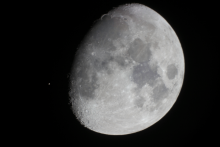Listen to today's episode of StarDate on the web the same day it airs in high-quality streaming audio without any extra ads or announcements. Choose a $8 one-month pass, or listen every day for a year for just $30.
You are here
Moon and Aldebaran
The waning Moon will flirt with the star Aldebaran the next couple of mornings. Orange Aldebaran is the brightest star of Taurus, the bull. It will stand to the lower left of the Moon at first light tomorrow, and about the same distance to the upper right of the Moon the next day.
Watching Aldebaran is like taking a trip in a time machine — it shows us what our own star, the Sun, will look like in the distant future.
Aldebaran is a giant — it’s more than 40 times the diameter of the Sun, and hundreds of times brighter. That’s because the star’s “normal” lifetime has come to an end. It’s “fused” the hydrogen in its core to make helium. Now, the core is shrinking and getting hotter. That’s causing Aldebaran’s outer layers to expand and cool.
Before long, the helium will begin to fuse to make oxygen and carbon. That’ll make the core even hotter, so the star will get bigger and brighter. Eventually, though, the helium will be used up. Aldebaran will lose its outer layers, leaving only its hot, small, dead core — a white dwarf — which will slowly fade from sight.
The Sun will continue to fuse its hydrogen for another few billion years. After that, it’ll experience the same process that Aldebaran’s going through now. It’ll get bigger and brighter, and look much like Aldebaran does today. After a billion years in that stage, though, the Sun, too, will die out — leaving only a dead reminder of its once brilliant life.
Script by Damond Benningfield




